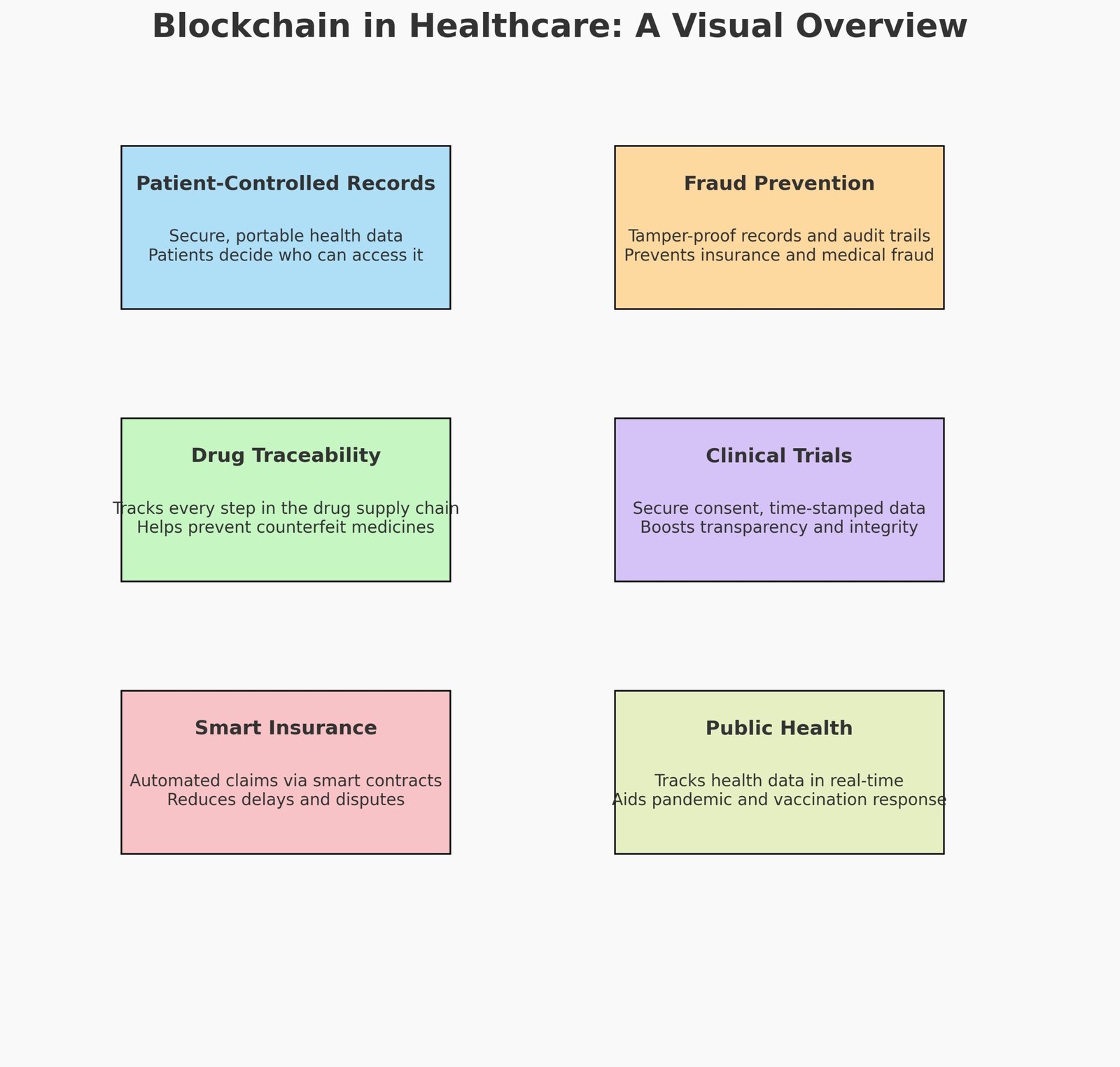Let’s face it — healthcare is buried in paperwork, constantly dealing with data leaks, and stuck with old systems that just don’t cut it anymore. That’s where blockchain comes in. This game-changing tech could completely change the way we store, share, and protect our health info. From tamper-proof medical records to streamlined insurance claims and improved patient trust, blockchain offers a digital makeover the industry desperately needs. It’s not just innovation—it’s a revolution in patient care, privacy, and efficiency.
When people hear the word “blockchain,” their minds often jump to Bitcoin or digital assets. But blockchain is more than just cryptocurrency—it’s a secure and decentralized technology that is starting to reshape industries. One of the most promising areas? Healthcare.
In this blog, I am sharing few findings on how blockchain technology is affecting healthcare and making it efficient, secure, and patient-centred. From managing medical records to drug tracking, blockchain is laying the foundation for a smarter, more connected healthcare system.

What is Blockchain? (A Simple Explanation)
At its core, blockchain is a distributed digital ledger. Think of it as a notebook that’s not stored in one place, but copied across a network of computers. Once data is recorded in this ledger, it can’t be changed unless the entire network agrees to it. That means data is:
- Decentralized – no single point of failure
- Immutable – once written, it cannot be changed
- Transparent – all changes are tracked and visible
This makes blockchain a powerful tool for handling sensitive healthcare data.
Why Blockchain is a Game-Changer for Healthcare
Healthcare faces a number of persistent challenges:
- Disconnected medical systems and databases
- Data breaches and privacy concerns
- Slow processes and high administrative costs
- Lack of trust and transparency
Blockchain offers solutions to many of these issues by enabling secure, transparent, and real-time data exchange.
1. Empowering Patients Through Portable Health Records
In the traditional system, patient records are siloed across hospitals, labs, and insurance providers. Blockchain can help by:
- Allowing patients to own and control their medical data
- Enabling real-time access to records from any provider
- Reducing redundant tests and procedures
Countries like Estonia have already implemented national systems using blockchain to give citizens secure access to their health records.
2. Enhancing Data Integrity and Preventing Fraud
Healthcare fraud is a multi-billion-dollar problem globally. Blockchain can help combat this by:
- Creating tamper-proof records of patient data, prescriptions, and treatments
- Providing audit trails for every transaction
- Enabling secure identity verification of patients and providers
This approach not only deters fraudulent activities but also fosters trust among stakeholders
3. Securing the Pharmaceutical Supply Chain
The drug supply chain is complex and vulnerable to counterfeit medications. Blockchain enhances visibility by:
- Tracking the journey of pharmaceuticals from manufacturing to delivery
- Recording every transaction in real time
- Ensuring authenticity and compliance at each stage
Companies like IBM and pharmaceutical leaders are already piloting blockchain platforms for drug traceability.
4. Improving Clinical Trials and Research Transparency
Clinical trials are vital for medical progress but often lack transparency. Blockchain addresses this by:
- Securing patient consent and making it easily revocable
- Recording data collection timestamps to validate research
- Allowing secure collaboration between research institutions
Blockchain-based research networks can help improve credibility and encourage open innovation.
5. Streamlining Insurance Claims and Payments
Insurance claims can take weeks and often involve disputes. Blockchain simplifies this through:
- Smart contracts that automatically process claims when predefined conditions are met
- Reducing manual paperwork and human error
- Offering transparency between patient, provider, and insurer
This leads to quicker payouts and an improved patient experience
6. Strengthening Public Health and Emergency Response
Blockchain can support public health monitoring and crisis management by:
- Collecting and validating real-time data from diverse sources
- Tracking vaccine and resource distribution during pandemics
- Combating misinformation with verified health data
These applications are critical in managing health emergencies effectively.
Key Benefits of Blockchain in Healthcare
- Data Security: Encryption and distributed architecture keep data safe.
- Patient Control: Individuals manage who accesses their health data.
- Operational Efficiency: Reduced paperwork and faster processing.
- Cost Reduction: Lower administrative and fraud-related expenses.
Barriers to Adoption
While promising, blockchain technology in healthcare is still in its early stages of development, challenges include
- Integration: Adapting legacy systems to new technology
- Scalability: Handling large volumes of data in real time
- Regulation: Navigating privacy laws like HIPAA and GDPR
- Awareness: Educating stakeholders on its use and benefits
These issues are being addressed gradually as more pilot programs demonstrate success.
Future Outlook: What’s Next?
The road ahead includes:
- Interoperable Health Platforms where blockchain links different providers
- Decentralized Research Networks that enhance collaboration
- AI + Blockchain Synergy to support predictive diagnostics and personalized care
These innovations are creating a healthcare system that’s more responsive, connected, and secure.
Conclusion: Trust, Transparency, and Transformation
Blockchain is not a magic fix, but it is a foundation for a smarter healthcare ecosystem. It gives patients control over their data, ensures security and accountability, and opens the door to seamless collaboration across the healthcare spectrum.
As the technology matures, blockchain will continue to support a vision of healthcare that is more accessible, trustworthy, and patient-focused.
Recommended Resources
Enjoyed this guide? Share it with a friend or healthcare professional who wants to stay ahead of the curve!